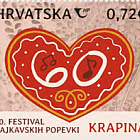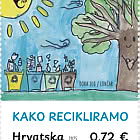Night Moths
The species is easily spotted on sunny days due to its very fast flight and during nectar sucking from nectar rich plants, when it reminds a curious viewer of a humming bird.
In cooperation with the World Wildlife Fund – WWF, Croatian Post has issued four commemorative postage stamps with the motif of Croatian olive bee hawk moth. On the stamps there is a panda mark, i.e. the logo of WWF, imprinted with the permission of the owner of the registered mark.
The olive bee hawk moth or Hemaris croatica (Esper, 1779) is a moth from the family of night moths - sphingidae, though it is active during daytime. The species has been described more than 230 years ago in the area of Karlovac and it is spread far outside Croatian borders living in Mediterranean and Pontus area from Italy, Switzerland, across Balkan Peninsula to Israel, Ukraine and Russia. When we compare it with other species from the family of sphingidae Croatian olive bee hawk moth is small, of olive green colour on the upper side of front wings and reddish colour on the front side of back wings. The species is easily spotted on sunny days due to its very fast flight and during nectar sucking from nectar rich plants, when it reminds a curious viewer of a humming bird. In one year two generations of this moth develop, first from the end of April to June and the second in August and September.
Croatian olive bee hawk moth is present in large numbers in the karst, thermophilic area of Croatia while recently it has not been spotted in the area of its first description, Karlovac. Caterpillars of this kind of moth feed on plants from the genera of knautia, asperula and cephalaria. Croatian olive bee hawk moth has been chosen as a symbol of the Croatian Entomological Society and adorns the front cover of the periodical Entomologia Croatica.
Croatia - Recommended stamp issues
WOPA+ recommended stamp issues
| Avatar - Fire and Ash |
| Issued: 03.12.2025 |
| ›New Zealand |
| 50th Anniversary of the Founding of the 24th November Bar Scout |
| Issued: 24.11.2025 |
| ›Montenegro |
| Krisjanis Valdemars |
| Issued: 02.12.2025 |
| ›Latvia |
| Sign Language - Good |
| Issued: 02.12.2025 |
| ›Bosnia and Herzegovina - Republic of Srpska |
| In Memory of the Fallen and Murdered on October 7, 2023 |
| Issued: 08.10.2025 |
| ›Israel |
| Annual Collection Folder (New York) |
| Issued: 05.12.2025 |
| ›United Nations |
| Year Set |
| Issued: 24.11.2025 |
| ›Isle of Man |
| Shipping in the 17th and 18th Centuries - Peat Shipping |
| Issued: 05.12.2025 |
| ›Netherlands |










































